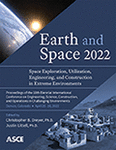ISRU Pilot Excavator: Bucket Drum Scaling Experimental Results
Publication: Earth and Space 2022
ABSTRACT
NASA’s Space Technology Mission Directorate (STMD) is funding the development of a robotic excavator called the “ISRU Pilot Excavator” (IPEx) which will be a technology demonstration of excavating and transporting 10 metric tons of lunar regolith on the surface of the Moon with a 30 kg-class robotic excavator. IPEx will be the next generation of robotic excavators to use bucket drums as excavation tools. This is an evolution of the regolith advanced surface systems operations robot (RASSOR) developed at NASA’s Kennedy Space Center (KSC). Bucket drums are hollow cylinders with regularly spaced scoops around the perimeter. The drums rotate in one direction to collect regolith with the scoops. The regolith slides down an internal baffling system inside the drum which prevents the regolith from falling back out of the scoops. The captured regolith can then be transported while held in the drum and then deposited by rotating the drum in the opposite direction allowing the regolith to slide back down the baffling and out of the excavation scoops. Bucket drums were developed by Lockheed Martin in 2008 and used on multiple robotic excavator prototypes ever since. However, the forces on a bucket drum and considerations for scaling have not been measured in detail. Bucket drums are challenging to model using classical blade\bucket equations because of their unique geometry. Therefore, this experiment was performed to measure the forces on three bucket drums of the same geometry at different scales. Small: 9.4” (239 mm) dia. × 8.1” (206 mm) width, medium: 11.6” (294 mm) dia. × 10” (254 mm) width, and large: 17” (432 mm) dia. × 14.1” (358 mm) width. The test stand consisted of an actuated gantry with controlled motion in the vertical (Z) and horizontal (X) axes and a single rotation axis (R). The bucket drums were individually mounted to the rotary axis of the test stand and translated across a prepared bed of Black Point 1 (BP-1) lunar regolith simulant at a specified linear speed and cutting depth. The test stand was outfitted with a torque sensor in line with the rotation of the drum (R) and a 3 axis (X, Y, and Z) load cell. In addition to the three sizes of bucket drums the linear excavation speed and cutting depth were test variables. The results of these experiments show the relationship between the three scales of bucket drums for factors such as: excavation force, torque due to regolith rotation inside the drum, excavation energy, time to fill, etc. and will be discussed in detail in this paper. This fundamental data will be used in the design of IPEx and can inform the design of future bucket drum excavators.
Get full access to this article
View all available purchase options and get full access to this chapter.
REFERENCES
Clark, D., Patterson, R., & Wurts, D. “A novel approach to planetary regolith collection: the bucket drum soil excavator.” AIAA Space 2009 Conference & Exposition. 2009.
Dickson, D. C., Sibille, L., Galloway, G. M., Mueller, R. P., Smith, J. D., Mantovani, J. G., & Schreiner, S. (2016). Modeling Dynamics of Counter-Rotating Bucket Drum Excavation for In Situ Resource Utilization (ISRU) in Low-Gravity Environments. Earth and Space 2016.
Gallo, C. A., Wilkinson, R. A., Mueller, R. P., Schuler, J. M., & Nick, A.J. (2010). Comparison of ISRU Excavation System Model Blade Force Methodology and Experimental Results. NASA/TM-2010-215591. Glenn Research Center, Cleveland, OH.
Mueller, R. P., Cox, R. E., Ebert, T., Smith, J. D., Schuler, J. M., & Nick, A. J. (2013, March). Regolith Advanced Surface Systems Operations Robot (RASSOR). In Aerospace Conference, 2013 IEEE (pp. 1–12). IEEE.
Mueller, R. P., Smith, J. D., Schuler, J. M., Nick, A. J., Gelino, N. J., Leucht, K. W., Townsend, I. I., & Dokos, A. G. (2016). Design of an Excavation Robot: Regolith Advanced Surface Systems Operations Robot (RASSOR) 2.0. Earth and Space 2016.
Suescun-Florez, E., Roslyakov, S., Iskander, M., & Baamer, M. (2014). Geotechnical Properties of BP-1 Lunar Regolith Simulant. American Society of Civil Engineers (ASCE), Reston, VA.
Wilkinson, A. & DeGenarro, A. (2007). “Digging and pushing lunar regolith: Classical soil mechanics and the forces needed for excavation and traction.” Journal of Terramechanics 44, 133–152.
Zelenin, A., Balovnev, V., & Kerov, I. (1975). Machines for Moving the Earth: Fundamentals of the Theory of Soil Loosening, Modeling of Work Processes and Forecasting Machine Parameters. Amerind Publishing Co. and Mashinostroenie, Moscow.
Zeng, X., Burnoski, L., Agui, J., & Wilkinson, A. (2007). Calculation of Excavation Force for ISRU on Lunar Surface. 45th AIAA Aerospace Sciences Meeting and Exhibit, Reno, NV.
Information & Authors
Information
Published In
History
Published online: Jan 5, 2023
Authors
Metrics & Citations
Metrics
Citations
Download citation
If you have the appropriate software installed, you can download article citation data to the citation manager of your choice. Simply select your manager software from the list below and click Download.
